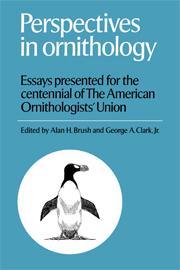 Perspectives in Ornithology
Perspectives in Ornithology Book contents
- Frontmatter
- Contents
- List of contributors
- Preface
- Introduction
- 1 Captive birds and conservation
- 2 Research collections in ornithology – a reaffirmation
- 3 On the study of avian mating systems
- 4 Cooperative breeding strategies among birds
- 5 Ecological energetics: what are the questions?
- 6 Perspectives in optimal foraging
- 7 Biochemical studies of microevolutionary processes
- 8 Organization of the avian genome
- 9 The origin and early radiation of birds
- 10 Avian community ecology: an iconoclastic view
- 11 Biogeography: the unification and maturation of a science
- 12 Bird song learning: theme and variations
- 13 Bird navigation
- Index
4 - Cooperative breeding strategies among birds
Published online by Cambridge University Press: 04 August 2010
- Frontmatter
- Contents
- List of contributors
- Preface
- Introduction
- 1 Captive birds and conservation
- 2 Research collections in ornithology – a reaffirmation
- 3 On the study of avian mating systems
- 4 Cooperative breeding strategies among birds
- 5 Ecological energetics: what are the questions?
- 6 Perspectives in optimal foraging
- 7 Biochemical studies of microevolutionary processes
- 8 Organization of the avian genome
- 9 The origin and early radiation of birds
- 10 Avian community ecology: an iconoclastic view
- 11 Biogeography: the unification and maturation of a science
- 12 Bird song learning: theme and variations
- 13 Bird navigation
- Index
Summary
The cooperative rearing of young is a topic of considerable interest to both biological and social scientists. Such behavior reaches its extreme development in many eusocial insect societies, where vast numbers of individuals live their entire lives as sterile workers, rearing young but never themselves becoming reproductives (Wilson 1971). Such sterile castes have not yet been reported among vertebrates. However, there are numerous instances in which individuals of vertebrate species (most of them avian) forego breeding for a significant portion of their adult lives and spend such time helping to rear offspring that are not genetically their own.
There are three fundamental questions surrounding the topic of cooperative breeding in animals. First, what role have ecological factors played in promoting the development of such aid-giving societies? Second, how can such seemingly altruistic behavior be explained in terms of natural selection theory? Third, what behavioral tactics will members of such societies adopt to maximize their own fitness when interacting with others?
In this chapter, we will attempt to address each of these three topics. Before doing so, however, it is necessary for us to define our terms. We use “group” to describe any long-lasting association of more than two individuals (Rowley et al. 1979). An “auxiliary” is any mature, nonbreeding member of a reproducing group. It may or may not provide aid in the rearing of young. “Cooperative breeding” refers to any case where more than two birds provide care in the rearing of young.
- Type
- Chapter
- Information
- Perspectives in OrnithologyEssays Presented for the Centennial of the American Ornitholgists' Union, pp. 93 - 134Publisher: Cambridge University PressPrint publication year: 1983
- 56
- Cited by


